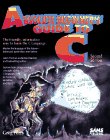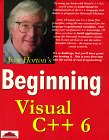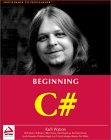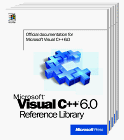
|
Learning C Learning C++ Learning C++ for Linux Learning MS Visual C++ Learning C# C Graphics MS Visual C++ reference  Learning C:
Absolute Beginner's Guide to C
Learning C:
Absolute Beginner's Guide to CBy Greg M. Perry. Published by Sams Publishing (April 1994) Paperback - 432 pages The C language is not a simple language to understand. However, this book will effectively teach you the very basics of C to get you started on the right track. The book assumes no programming knowledge. It is presented in a clear and friendly style without a lot of heavy code. From the Back Cover For beginning programmers, this updated edition answers all C programming questions. This bestseller talks to readers at their level, explaining every aspect of how to get started and learn the C language quickly. Readers also find out where to learn more about C. This book includes tear-out reference card of C functions and statements, a hierarchy chart, and other valuable information. It uses special icons, notes, clues, warnings, and rewards to make understanding easier. And the clear and friendly style presumes no programming knowledge.  Learning C++:
Sam's Teach yourself C++ in 21 days
Learning C++:
Sam's Teach yourself C++ in 21 daysBy Jesse Liberty. Published by Sams Publishing (April 2001) Paperback + CD - 640 pages There is a lot of C++ texts out there. What sets this one out from the crowd is the excellent line by line analysis of each example so that you know exactly what is going on in each program. You know the critical lines in each program as well, so you can confidently alter parts and learn even more as you go. This text brings not just the technical words of C++, it gives you awareness and understanding of the concepts. From the Back Cover This product contains: * Sams Teach Yourself C++ in 21 Days, provides a straight-forward tutorial approach to programming in C++. It assumes no prior knowledge of programming and offers both solid instruction and the authors insights into best programming and learning practices. The book also provides a foundation for understanding object-oriented programming. * ANSI-Compliant C++ Compiler * Compiler Installation Booklet  Learning C++ for Linux:
Sam's Teach yourself C++ for Linux in 21 days
Learning C++ for Linux:
Sam's Teach yourself C++ for Linux in 21 daysBy Jesse Liberty, David B. Horvath. Published by Sams Publishing (May 2001) Paperback + CD - 1109 pages Twenty-six tutorials introduce programming with C++ under the Linux operating system, covering such fundamentals as managing input/output, loops and arrays, object-oriented programming, templates, and creating applications. The CD-ROM contains source code, third party utilities, and Mandrake Linux 6.1 From the Back Cover Sams Teach Yourself C++ Programming for Linux in 21 Days teaches you the C++ programming language using the Linux operating system. You will gain a thorough understanding of the basics of C++ programming from a Linux perspective. The Bonus Week includes topics such as XWindows, KDE with QT toolkit, APE Class Library, and Real -time Middleware.  Learning MS Visual C++:
Beginning Visual C++ 6
Learning MS Visual C++:
Beginning Visual C++ 6By Ivor Horton. Published by John Franklin Paperback - 1184 pages "Windows programming is not difficult," observes well-respected author Ivor Horton in his book Beginning Visual C++ 6. "In fact, Microsoft Visual C++ 6.0 makes it remarkably easy." Horton's treatment of Visual C++ continues the expert author's thorough and patient presentation of the best of today's object-oriented computer languages. (Besides C++, the author has written the excellent Beginning Java for Java developers). This massive, yet quite comprehensible, tutorial covers all the essential features of C++ used with Microsoft Visual C++ 6. Horton's book is the ideal choice for programmers who don't want to skimp on their general knowledge of C++. The author covers all the bases here in a title that will certainly compare favorably with any other Visual C++ tutorial on the market today. From the Back Cover Visual C++ 6 is the latest incarnation of Microsoft's premier development product for C++ developers. It contains the latest version of the MFC&T (Microsoft Foundation Classes & Templates) which has virtually become the Industry-wide library used to write Windows programs. Visual C++ 6 also contains the Active Template Library 3.0 ( ATL ), which is a framework and collection of Wizards for writing ActiveX & COM controls. This book is a tutorial in use of all the major functions of Visual C++ 6.Proven teaching methods guarantee success to novice C++ programmers with a complete tutorial from 'vanilla' C++, through to OO programming, Windows and using MFC&T. Each concept is supported by graduated code examples and the reader will be coherent in writing a real Windows program and controls by the end of the book.  Learning C#:
Beginning C#
Learning C#:
Beginning C#By Karli Watson, Eric White and others. Published by Wrox Press (Sept 2001) Paperback - 1035 pages C# is Microsoft's brand new programming language for its new platform, the .NET Framework. The .NET Framework consists of a runtime environment for managing the execution of our code, and a whole host of class libraries for performing almost any programming task you can think of. Although .NET code can be written in many languages, C# is the only language designed specifically for the .NET Framework, and as such is set to become the language of choice for writing .NET applications for years to come. This book will be an indispensable guide as you learn to write C# programs, gradually explaining the key concepts of C# and .NET as your skills develop. After a thorough explanation of the basics of the C# language, we take an in-depth look at object-oriented programming in C#, before moving on to see how we write Windows applications in C#. We also show how you can create dynamic web pages and web services in C#. Finally, two case studies provide full examples of C# applications in action and show how it all ties together. This book covers: * The C# language * .NET Programming with C# * Object-oriented programming * Writing Windows applications * Accessing databases * Writing web pages and web services in C#  C Graphics:
Computer Graphics : Principles and Practice, Second Edition in C
C Graphics:
Computer Graphics : Principles and Practice, Second Edition in CBy James D. Foley, Andries van Dam and others. Paperback - 1175 pages This book is the most exhaustive overview of computer graphics techniques available. This textbook's 21 chapters cover graphics hardware, user interface software, rendering, and a host of other subjects. Assuming a solid background in computer science or a related field, Computer Graphicsgives example programs in C and provides exercises at the end of each chapter to test your knowledge of the material. The guide has over 100 beautiful, full-color photographs that illustrate important topics and algorithms, such as ray tracing and bump maps, and also inspire you to acquire the skills necessary to produce them. Encyclopedic in its coverage, the book has a good table of contents so that you can immediately turn to information on the z-Buffer algorithm or the chapter on animation. From the Inside Flap This text can be used by those without prior background in graphics and only some background in Pascal programming, basic data structures and algorithms, computer architecture, and simple linear algebra. An appendix reviews the necessary mathematical foundations. The book covers enough material for a full-year course, but is partitioned into groups to make selective coverage possible. The reader, therefore, can progress through a carefully designed sequence of units, starting with simple, generally applicable fundamentals and ending with more complex and specialized subjects. Basic Group. Chapter 1 provides a historical perspective and some fundamental issues in hardware, software, and applications. Chapters 2 and 3 describe, respectively, the use and the implementation of SRGP, a simple 2D integer graphics package. Chapter 4 introduces graphics hardware, including some hints about how to use hardware in implementing the operations described in the preceding chapters. The next two chapters, 5 and 6, introduce the ideas of transformations in the plane and 3-space, representations by matrices, the use of homogeneous coordinates unify linear and affine transformations, and the description of 3D views, including the transformations from arbitrary view volumes to canonical view volumes. Finally, Chapter 7 introduces SPHIGS, a 3D floating-point hierarchical graphics package that is a simplified version of the PHIGS standard, and describes its use in some basic modeling operations. Chapter 7 also discusses the advantages and disadvantages of the hierarchy available in PHIGS and the structure of applications that use this graphics package. User Interface Group. Chapters 8-10 describe the current technology of interaction devices and then address the higher-level issues in user-interface design. Various popular user-interface paradigms are described and critiqued. In the final chapter user-interface software, such as window mangers, interaction technique-libraries, and user-interface management systems, is addressed. Model Definition Group. The first two modeling chapters, 11 and 12, describe the current technologies used in geometric modeling: the representation of curves and surfaces by parametric functions, especially cubic splines, and the representation of solids by various techniques, including boundary representations and CSG models. Chapter 13 introduces the human color-vision system, various color-description systems, and conversion from one to another...  MS Visual C++ reference:
Microsoft Visual C++ 6.0 Reference Library
MS Visual C++ reference:
Microsoft Visual C++ 6.0 Reference LibraryBy Microsoft corporation. Paperback - 5072 pages Volumes 1 and 2 of this package comprise the voluminous reference to the Microsoft Foundation Classes (MFC) library. These two books, totaling more than 3,000 pages, provide detailed information on the MFC classes, functions, macros, and variables. Volume 1 opens with an outline of the MFC by category, while the second installment offers a detailed reference to each class. The third volume in this set covers the template libraries in Visual C++ 6.0. This book opens with a technical discussion of the Active Template Library (ATL) and a brief ATL tutorial. The remainder of the volume is devoted to the detailed reference of the ATL. The first part of the Run-Time Library Reference, the next volume in the series, details the C++ iostream library--with a quick discussion of streams and iostream programming--and alphabetically lists Microsoft's iostream classes. The second portion of this book lists the run-time routines by category. Each routine is followed up by global variables, types, and constants. The last volume in this group is actually three books in one. The first is a detailed Visual C 6.0 reference that covers all the basic constructs, such as statements, functions, identifiers, and syntax. Next, an equally detailed reference to C++ discusses all of the object-oriented additions to C++. A reference guide to the preprocessor directives and macros follows these two language summaries. |
Copyright © 1999-2003 BigProf.com. All rights reserved.